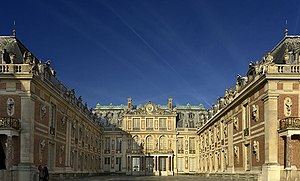


The Honneurs de la Cour (Honors of the Court) were ceremonious presentations to the sovereign at the Royal Court of France that were formal for women but more casual for men. It was an honour granted only to the families of ancient nobility. It allowed them to approach the King and the Queen of France.[1]
The Honors of the Court "were the most prestigious noble honour of the 18th century, meant to honour the most ancient and representing noble families".[2]
Formally such presentations were only granted to noble families able to prove a lineage dating back to 1400 A.D. without tracks of ennoblement. However, the king could grant exemptions to families that had been dedicated to serve him. He could also refuse a valid candidate with sufficient nobility whose family was not involved enough in the king's wars as nobles were primarily mounted warriors who had sworn allegiance to their sovereign and promised to fight for him. On a list of candidates he would then place a remark next to the name of the refused applicant saying "ne se peut" (can't be) or "attendre" (wait).
The Honors of the Court should not be mistaken for court life. The oldest nobility did not always match the court nobility. Many families living at court were descendants from less ancient nobility while many nobles of antique nobility did not stay at court. Moreover, life at the Versailles Court was expensive and many were unable to afford it.
The nobleman who was granted the presentation would follow a royal hunt on board of one of the king's carriages. At that point he would be casually introduced to the king. A noblewoman's presentation was much more formal, taking place during a specific ceremony.
From 1715 to 1790,[3] 942 families were granted the Honors of the Court; 880 of them were French. François Bluche, who studied the royal genealogical archives, said that among the 942 families "462 were able to prove a noble lineage dating back to 1400, if excluding sovereign houses and foreign nobles who, unlike one can think, made up more than half of the French nobleman received at Court".[4] He has limited his work to a list of 43 Houses especially flattered by the King's archive, these 43 families are considered of major regional or national importance and members of the highest 18th century nobility.
According to Régis Valette[2] only 280 of the 880 French families who were granted the Honors of the Court still remain today.

The following table provides an incomplete list of families who were granted the Honors of the Court, including dates (when available) and sources. The ones listed by François Bluche,[4] considered the most prominent French noble families of the 18th century, are marked with bold script.
| Name | Dates | Sources |
|---|---|---|
| d'Arenberg | 1749, 1767, 1771, 1774, 1776 et 1785 | Valette,[2] Piot[5] |
| deBéon | Bluche | |
| deBourbon-Busset | 1753, 1767, 1772 and 1773 | Valette, Piot |
| deBroglie | 1746, 1747, 1750, 1752, 1753, 1754, 1756, 1770, 1771, 1779, 1782, 1785 and 1786 | Valette, Piot |
| deButler and de Butler d'Ormond | 1747 | Valette, Piot |
| de Chabannes [fr] | 1759, 1760, 1782, 1784 and 1787 | Bluche, Valette |
| deChabot | 1778 | Valette |
| deChastellux | 1765, 1768, 1773 and 1787 | Bluche, Piot, Valette |
| deChoiseul | 1733 | Bluche, Valette |
| deClermont-Tonnerre | 12 times | Bluche, Valette |
| de Croismare | 1775, 1783, 1785 | De Magny, M. (1844)[6] |
| deColbert | 1748, 1758, 1759, 1763, 1764, 1768, 1770, 1772, 1778, 1782 and 1787 | Valette |
| deCoucy | 1776 | Bluche, Jougla (t. 3, n° 11398) |
| deCroÿ | Valette | |
| Diesbach de Belleroche | 1773 | Valette, Piot |
| deDrée | 1782 and 1783 | Valette, Piot |
| deDurfort and de Durfort-Civrac | before 1732, and 22 times between 1737 and 1788 | Bluche, Valette, Piot |
| d'Estaing | 1784 and 1785 | Bluche |
| deFaucigny-Lucinge | 1785 and 1787 | Valette, Piot |
| deFicquelmont | 1777 and 1789 | Bluche, Valette |
| deFoucauld (de Pontbriand and de Malembert) | 1765, 1769 and 1788 | Valette, Piot |
| deGironde | 1770 and 1779 | Valette |
| deGontaut-Biron | Bluche, Valette | |
| deGouffier | Bluche | |
| deGramont | Valette | |
| d'Harcourt | Valette | |
| d'Harville | Valette | |
| de la Croix de Castries | 1744, 1753, 1776 and 1786 | Valette |
| deLa Rochefoucauld | Bluche, Valette | |
| deLas Casas | dates | Valette |
| deLa Tremoïlle | Bluche | |
| deMancini | dates | Pauchet |
| deMérode | dates | Valette |
| deMontaigu | dates | Valette |
| deMontalembert | dates | Valette |
| deMontesquiou-Fezensac | dates | Valette |
| deMontmorency | Bluche, Valette | |
| deNoailles | Bluche, Valette | |
| dePolignac | Bluche, Valette | |
| deRochechouart, de Rochechouart de Mortemart | 1732, 1738, 1751, 1752, 1756, 1757, 1764, 1772, 1773, 1774, 1776, 1779, 1780 and 1783 | Bluche, Valette |
| deRohan | Bluche | |
| deRougé | dates | Valette |
| deSabran | Bluche | |
| deSade | dates | Valette |
| deSégur | dates | Valette |
| deVogüé | dates | Valette |
...(etre admis aux) honneurs de la Cour, c'est-a-dire aux cercles, aux receptions, aux bals du Roi et de la Reine, pour monter dans les carrosses de Sa majeste et l'accompagner a la chasse; in English: [the Honors of the Court meant] to be allow to attend the circles, receptions and balls of the King and the Queen, to get into His Majesty's carriages and to go hunting with the King.